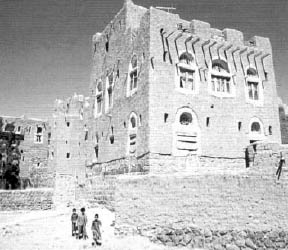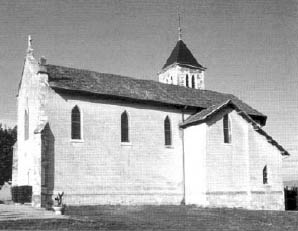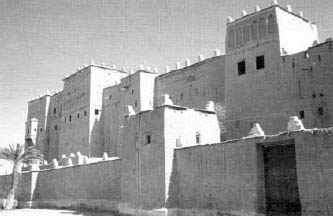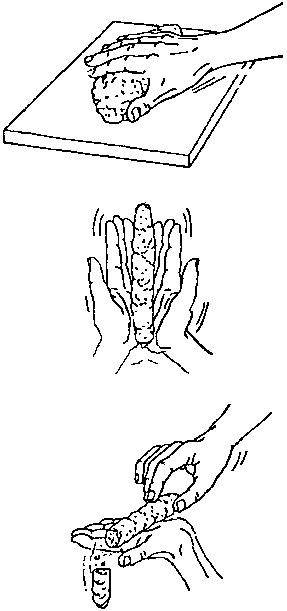Clay as a Binder
Contents
Why use clay as a binder
The binding properties of clay are generally low compared with cement and, as already noted, reversible with water. Buildings of unstabilised earth face the risk of erosion unless special design precautions are taken to reduce exposure to rain and moisture.
On the other hand, stabilizers and other additives or methods such as good compaction and grain size optimization can reduce swelling, shrinkage, and cracking, increasing strength and water resistance, thus allowing economy in building.
When clay is mixed with water it becomes malleable, plastic or liquid, allowing it to be shaped. When drying, clay sets and recovers its cohesive properties, and so can bind the soil together.
Most soils consist of clay together with proportions of silt, sand and gravel. The larger particles give structure to a soil, while the clay holds it together and to a great extent provides the cohesion.
Earth is a ready building material and needs little further processing. Generally, a fairly wet mix with higher proportions of clay is used in moulding and spreading applications, while a mix with less clay is best suited to compaction in a moist or damp state.
Building design
For durability, earth should only be used where it is not prone to water or damp and, for maximum advantage, appropriate designs and construction techniques need to be selected. Optimum designs will depend a lot on the environment (natural drainage, water table...), the climate (rainfall, quantity and intensity, winds during rains...), and on the maintenance practices of the users, as well as on the sensitivity of the soil to water.

Figure 2: Private house built in the town of Amran in Yemen in 1985 ©CRATeere/EAG
Stabilization
To reduce or completely eliminate the reversibility of its cohesion and swelling properties earth can be stabilized using a diverse range of physico-chemical stabilizers.
Traditional stabilizers, which are usually obtained as or derived from naturally occurring substances, are mainly used with traditional building techniques. They are of three different types: glues (gum Arabic, animal glue...), oily products (sheanut butter, linseed oil...) and tannins (horse urine, decoction of néré tree bark...). The efficiency of these products is very variable, and often depends on local skills. Few have been scientifically studied even though many can be very efficient.
The main industrial stabilizers are cement, lime, and bitumen, and comprehensive information exists about these. Many other synthetic products have been tried but their performance is questionable, and doubts exist on their cost effectiveness.
Types of clay and soil
The proportions of the different components in a natural soil (clay, silts, sand, gravels and pebbles) are very variable. Ideally for building a soil should have a continuous grainsize distribution.
Another fundamental point is that the quality of the clay obtained can be very variable in composition and in characteristics.
The three principal types of clay are:
• Kaolinite, which is relatively stable and has relatively low cohesion;
• Illite, which is of average stability and cohesion, and;
• Montmorillonite, which is highly sensitive to water and has high cohesion.
A soil usually contains a combination of these clay types.
Although the properties of different soils vary widely, there are some characteristic soils (laterites, terra rossa, black cotton soils, loess, saline soils, and alluvial soils) the properties of which are relatively well known.
Suitability of soils
Some soils are suitable for use without any additives. Others can be improved (by addition of inert materials or by physico-chemical stabilisation of the clays). Finally, some have to be rejected (mostly soils with a high clay content or with montmorillonite clays).
There are some general requirements for the suitability of a soil for construction, but other requirements are specific to a particular construction application.
To get a good building material, strong and easy to use, the proportion of clay in a soil should be 15 per cent on average.
However, depending on cohesiveness of the clay relative to specific surface of the inert elements, generally 10 to 20 per cent clay content would be acceptable. The sand should be 40 to 80 per cent, the gravel 0 to 40 per cent and the silt 10 to 25 per cent.
If the clay content in a soil is too high, some minerals (sand, gravels…) or fibres (straw, hair…) can be added.
Identification of soils
Some simple field tests can be used to estimate the proportions of components in the soil to assess its suitability and to indicate how much stabilizer to use. They are also very useful for quality control.
Feeling the texture of the soil gives an indication of sand and gravel proportions as well as, when wet, its cohesiveness and strength. By letting the soil settle in water in a transparent container the sizes of the different layers indicates proportions of the components.
To estimate cohesion make a small biscuit or briquette of soil and observe if shrinkage is excessive after drying. After that, estimate its cohesiveness by the effort needed to break it. You can also roll a cigar (3cm in diameter) from a moistened and well-kneaded piece of soil and push it gently across the palm of the hand until a piece breaks off.
If the length of this piece is less than 5 cm, the soil contains too much sand, between 5 and 15 cm the soil is good, more than 15 cm and the soil contains too much clay.
Laboratory-based tests have also been developed and these are more accurate indicators.
Use of clays for mortars and plasters
An important application of earth for building, whether stabilized or not, is in mortars, plasters and renders. An essential requirement of these applications is that the materials used should not be significantly stronger than the backgrounds, otherwise the backgrounds can be damaged.
Plasters or renders are important in protecting walls from damage by rain, wind and abrasion, as well as for decorative effect, and earth-based materials are quite often used. Two further leaflets in this series describe these important applications of clays as building materials.

Figure 3: Church built in pisé (rammed earth) at Charancieu in the Dauphiné region of France ©CRATerre/EAG

Figure 4: The Kasbah of the Glaoui at Ouarzazate in Morocco. Built by the beginning of the 20th century ©CRATerre/EAG
References and further readings
Additives to Clay: Organic additives derived from Natural Sources, Practical Action Technical Brief
Additives to Clay: Minerals and synthetic additives, Practical Action Technical Brief
Mud Plasters and Renders: An Introduction Practical Action Technical Brief
Mud as a Mortar Practical Action Technical Brief
Earth construction, A comprehensive guide, CRATerre, ITDG Publishing, 1994.
Building with earth, CRATerre, Mud Village Society, Delhi, India, 1990.
Building with earth, A handbook, 2nd Ed., J. Norton, ITDG Publishing, 1997.
Soil preparation equipment (product information), GATE
Earth building materials and techniques, Select bibliography, CRATerre, GATE, 1991.
The basics of compressed earth blocks, CRATerre, GATE, 1991.
Appropriate building materials, A catalogue of potential solutions, 3rd Ed., R. Stulz, K. Mukerji, SKAT/ITDG Publishing, 1993
Earthen Architecture, Hands On Brief, ITDG/TVE, Series 1,
http://www.tve.org/ho/doc.cfm?aid=395&lang=English
Compressed Earth Blocks: Vol. 1, Manual of Production, Vince Rigassi, CRATerre-EAG, GATE/GTZ, 1985, http://www2.gtz.de/Basin/publications/books/CEBVol1.pdf
Useful contacts
CRATerre
Maison Levrat (Parc Fallavier)
B. P. 53, F-38092 Villefontaine -CEDEX
France
Tel: +33 474 954391
Fax: +33 474 956421
E-mail: craterre@club-internet.fr
Website: http://www.craterre.archi.fr
CRATerre is the international centre for earth construction at the school of Architecture in Grenoble. CRATerre is a member of basin.
Auroville Earth Institute
Auroshilpam, Auroville 605 101,
T.N. India
Tel: +91 413 262 3064/262 3330
Fax: +91 413 262 2886
Website: http://www.earth-auroville.com/
References and further reading
This Howtopedia entry was derived from the Practical Action Technical Brief Energy from the Wind.
To look at the original document follow this link: http://www.practicalaction.org/?id=technical_briefs_construction
Useful addresses
Practical Action
The Schumacher Centre for Technology & Development, Bourton on Dunsmore, RUGBY, CV23 9QZ, United Kingdom.
Tel.: +44 (0) 1926 634400, Fax: +44 (0) 1926 634401
e-mail: practicalaction@practicalaction.org.uk
web: www.practicalaction.org

Categories
- Medium
- Between 50 and 200 US$
- Between 2 and 5 People
- Global Technology
- Construction
- Principles
- Application
- Energy
- Ideas
- Products
- Recycling
- Small Business
- Waste
- Water
- Monsoon Climate
- Montaneous Environment
- Rural Environment
- Temperate Climate
- Tropical Climate
- Urban Environment
- Ashes
- Fly Ash
- Coal
- Lime
- Clay
- Cement
- Rice Husk
- Bricks
- Soil
- Kaolin
- Howtopedia requested drawings
- Howtopedia requested images
- Practical Action Update
- Requested translation to Spanish
